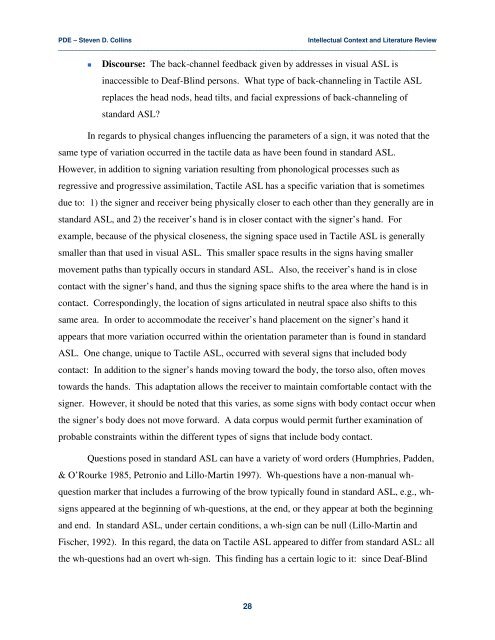Adverbial Morphemes in Tactile ASL - Gallaudet University
Adverbial Morphemes in Tactile ASL - Gallaudet University
Adverbial Morphemes in Tactile ASL - Gallaudet University
You also want an ePaper? Increase the reach of your titles
YUMPU automatically turns print PDFs into web optimized ePapers that Google loves.
PDE – Steven D. Coll<strong>in</strong>s<br />
Intellectual Context and Literature Review<br />
_________________________________________________________________________________________________________<br />
<br />
Discourse: The back-channel feedback given by addresses <strong>in</strong> visual <strong>ASL</strong> is<br />
<strong>in</strong>accessible to Deaf-Bl<strong>in</strong>d persons. What type of back-channel<strong>in</strong>g <strong>in</strong> <strong>Tactile</strong> <strong>ASL</strong><br />
replaces the head nods, head tilts, and facial expressions of back-channel<strong>in</strong>g of<br />
standard <strong>ASL</strong>?<br />
In regards to physical changes <strong>in</strong>fluenc<strong>in</strong>g the parameters of a sign, it was noted that the<br />
same type of variation occurred <strong>in</strong> the tactile data as have been found <strong>in</strong> standard <strong>ASL</strong>.<br />
However, <strong>in</strong> addition to sign<strong>in</strong>g variation result<strong>in</strong>g from phonological processes such as<br />
regressive and progressive assimilation, <strong>Tactile</strong> <strong>ASL</strong> has a specific variation that is sometimes<br />
due to: 1) the signer and receiver be<strong>in</strong>g physically closer to each other than they generally are <strong>in</strong><br />
standard <strong>ASL</strong>, and 2) the receiver’s hand is <strong>in</strong> closer contact with the signer’s hand. For<br />
example, because of the physical closeness, the sign<strong>in</strong>g space used <strong>in</strong> <strong>Tactile</strong> <strong>ASL</strong> is generally<br />
smaller than that used <strong>in</strong> visual <strong>ASL</strong>. This smaller space results <strong>in</strong> the signs hav<strong>in</strong>g smaller<br />
movement paths than typically occurs <strong>in</strong> standard <strong>ASL</strong>. Also, the receiver’s hand is <strong>in</strong> close<br />
contact with the signer’s hand, and thus the sign<strong>in</strong>g space shifts to the area where the hand is <strong>in</strong><br />
contact. Correspond<strong>in</strong>gly, the location of signs articulated <strong>in</strong> neutral space also shifts to this<br />
same area. In order to accommodate the receiver’s hand placement on the signer’s hand it<br />
appears that more variation occurred with<strong>in</strong> the orientation parameter than is found <strong>in</strong> standard<br />
<strong>ASL</strong>. One change, unique to <strong>Tactile</strong> <strong>ASL</strong>, occurred with several signs that <strong>in</strong>cluded body<br />
contact: In addition to the signer’s hands mov<strong>in</strong>g toward the body, the torso also, often moves<br />
towards the hands. This adaptation allows the receiver to ma<strong>in</strong>ta<strong>in</strong> comfortable contact with the<br />
signer. However, it should be noted that this varies, as some signs with body contact occur when<br />
the signer’s body does not move forward. A data corpus would permit further exam<strong>in</strong>ation of<br />
probable constra<strong>in</strong>ts with<strong>in</strong> the different types of signs that <strong>in</strong>clude body contact.<br />
Questions posed <strong>in</strong> standard <strong>ASL</strong> can have a variety of word orders (Humphries, Padden,<br />
& O’Rourke 1985, Petronio and Lillo-Mart<strong>in</strong> 1997). Wh-questions have a non-manual whquestion<br />
marker that <strong>in</strong>cludes a furrow<strong>in</strong>g of the brow typically found <strong>in</strong> standard <strong>ASL</strong>, e.g., whsigns<br />
appeared at the beg<strong>in</strong>n<strong>in</strong>g of wh-questions, at the end, or they appear at both the beg<strong>in</strong>n<strong>in</strong>g<br />
and end. In standard <strong>ASL</strong>, under certa<strong>in</strong> conditions, a wh-sign can be null (Lillo-Mart<strong>in</strong> and<br />
Fischer, 1992). In this regard, the data on <strong>Tactile</strong> <strong>ASL</strong> appeared to differ from standard <strong>ASL</strong>: all<br />
the wh-questions had an overt wh-sign. This f<strong>in</strong>d<strong>in</strong>g has a certa<strong>in</strong> logic to it: s<strong>in</strong>ce Deaf-Bl<strong>in</strong>d<br />
28
















